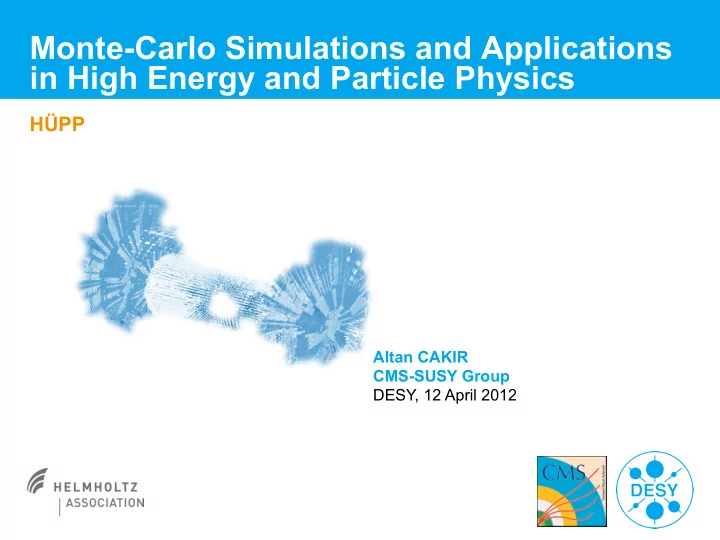

Monte-Carlo Simulations and Applications in High Energy and Particle Physics HÜPP Altan CAKIR CMS-SUSY Group DESY, 12 April 2012
OUTLINE I. Basics i. Introduction ii. Monte-Carlo techniques iii. MC Sampling techniques II. Perturbative physics I. Hard Scattering II. Parton Showers III. Non-perturbative physics I. Hadronization and hadron decays II. Comparison to data IV. MC Simulations in HEP (Theory) V. MC Simulations for physics analyses (Experiments) Altan CAKIR | MC Simulations and Applications in HEP| 03 May 2011 | Page 2
Summary of the first lecture Decay Hadronization Parton Shower + Minimum Bias Collisions Hard SubProcess f(x,Q 2 ) f(x,Q 2 ) Parton Distributions Altan CAKIR | MC Simulations and Applications in HEP| 03 May 2011 | Page 3
Monte Carlo Overview Phase Space ME Generator Process Selection Generation Resonance Decays ME Expression Parton Showers PDF Library SUSY/. . . Multiple Interactions spectrum Beam Remnants calculation τ Decays Use Hadronization specialized programs Ordinary Decays B Decays Detector Simulation [Sjöstrand, arXiv:hep-ph/0611247v1] Altan CAKIR | MC Simulations and Applications in HEP| 03 May 2011 | Page 4
MC Generator Classes Pure matrix element (ME) simulation: ! MC integration of cross section & PDFs, no hadronization ! (recall: cross section = |matrix element| 2 ⊗ phase space) " Useful for theoretical studies, no exclusive events generated " [Example: MCFM (http://mcfm.fnal.gov); many LHC processes up to NLO] Event generators: " Combination of ME and parton showers ... ! Typical: generator for leading order ME ! combined with leading log (LL) parton shower MC ! Exclusive events ! useful for experimentalists ... Altan CAKIR | MC Simulations and Applications in HEP| 03 May 2011 | Page 5
Recommend
More recommend